
rtd sensors

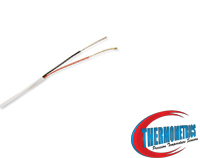
2-Wire RTD
Using the 2-wire method, the two wires that provide the RTD with its excitation current and the two wires across which the RTD voltage is measured are the same.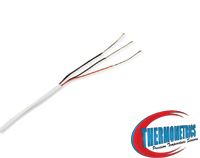
3-Wire RTD
In a three wire RTD one of the wires is connected to one side of the temperature element and the remaining two wires are connected to the other side of the element. .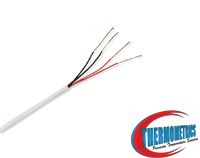
4-Wire RTD
The optimum form of connection for RTDs is a four-wire circuit. It removes the error caused by mismatched resistance of the lead wires..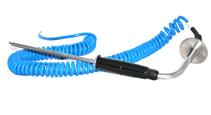
Pierce Probe Sensors
Piercing probe temperature sensor is manufactured with heavy wall tubing to provide support for production line handling and a spring relief.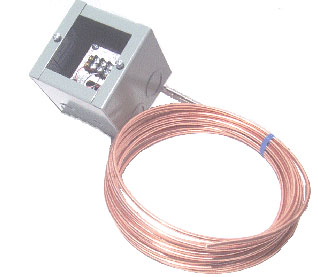
HVAC RTD Sensors
Our HVAC assemblies are made for easy installation, high reliability, and compatibility with most building automation systems.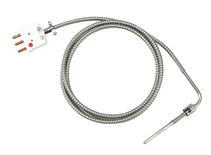
Field Adjustable Sensor
Field Adjustable Sensors are ideal for applications involving various sheath lengths that are best determined on site, rather than on an engineering drawing.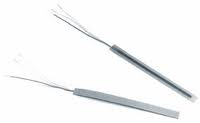
RTD Temperature Elements
RTD elements are used to manufacture temperature sensors. A resistance element is the temperature sensing component at the heart of an RTD or resistance thermometer.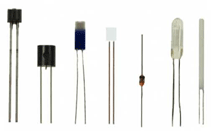
Thin Film RTDs
Platinum Thin Film RTD Elements are fabricated using state-of-the-art thin film processing techniques, resulting in an element of exceptional quality and stability.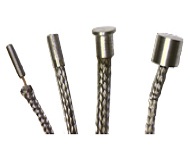
Embedment RTDs
Recognition of rising temperature can provide a warning of the breakdown of the bearing lubricating oil film; thus allowing machine shutdown and maintenance to take place. Prevention is always better than replacment.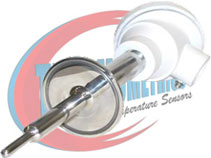
Sanitary RTDs
Sanitary RTD sensors provide precise temperature measurements for Sanitary applications found in the Food, Dairy, Beverage, Pharmaceutical and Chemical Industries.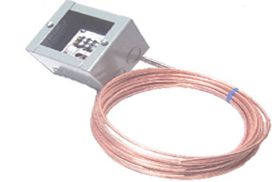
Averaging Sensor
The averaging RTD sensors listed below measure the temperature over the entire sheath length to provide an average temperature measurement of the cross sectional area of air ducts, room gradient temperatures, and other low temperature averaging applications.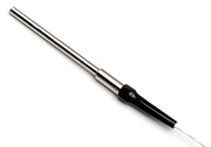
Platinum Thermometer
Resistance thermometers,(RTDs), are temperature sensors that exploit the predictable change in electrical resistance of some materials with changing temperature.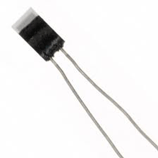
PT100 RTD
PT100 sensors offer excellent accuracy over a wide temperature range (from -200 to +850 C).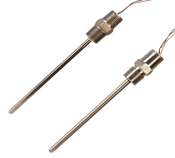
PT1000 RTD
The Pt1000 has 1000 ohms resistance at 0 C. These sensors are normally fitted into some type of protective sheath or mounting to form a probe.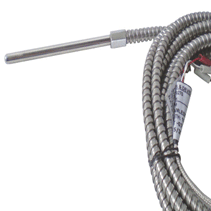
Flex Armor Thermocouple
Flex armor temperature sensors are commonly used in extruder and plastic processing and bearing industries.
Bayonet RTD
Universal design allows for quick thermocouple or RTD installation into existing twist-lock adapters.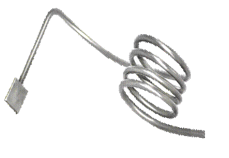
Weld Pad Sensor
Weld Pad RTD and Thermocouple sensors are commonly used in Petro-Chemical industries. These sensors are welded to pipe to provide a measurement of process temperature.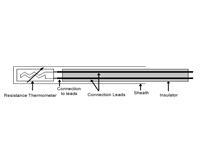
RTD Resistor
A Resistor is a two-terminal electronic component that produces a voltage across its terminals that is proportional to the electric current passing through it in accordance with OHM's law.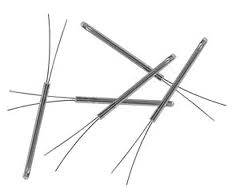
Wire Wound Element
Wire wound elements are basically a "hand made" product which involves lot of skilled Labor. It is manufactured by placing a coil of thin wire into a ceramic insulator. The resistance of the coil is suitably adjusted to the ohms corresponding to that particular temperature.Resistance Temperature Detector: Theory and Standards
With these general guidelines to the basic function, performance, and recognized standards for RTD's, anyone can specify the right device for the application.
Setting the specifications for any sensor or instrument can be a difficult process, and RTD's (resistance temperature detectors) are no exception. No one can be expected to be an expert in all fields, and frankly, no one needs to be. With these general RTD guidelines, along with a little common sense and background information on the application, you will successfully detail the specifications of an RTD that will satisfy your requirements.

Theory of Operation
A basic physical property of a metal is that its electrical resistivity changes with temperature. All RTD's are based on this principle. The heart of the RTD is the resistance element. Several varieties of semi-supported wire-wound fully supported bifilar wound glass, and thin film type elements are shown here.Some metals have a very predictable change of resistance for a given change of temperature; these are the metals that are most commonly chosen for fabricating an RTD. A precision resistor is made from one of these metals to a nominal ohmic value at a specified temperature. By measuring its resistance at some unknown temperature and comparing this value to the resistor's nominal value, the change in resistance is determined. Because the temperature vs. resistance characteristics are also known, the change in temperature from the point initially specified can be calculated. We now have a practical temperature sensor, which in its bare form (the resistor) is commonly referred to as a resistance element.
RTD Specifications?
Eight salient parameters must be addressed for every RTD application to ensure the desired performance. Many will be specified by the manufacturer of the instrument to which the RTD will be connected. If it is a custom circuit or special OEM application, the designers must make all the decisions. The four specifications dictated by the instrumentation or circuitry are: sensor material, temperature coefficient, nominal resistance, and, to some extent, wiring configuration. Sensor Material Several metals are quite common for use in RTD's, and the purity of the metal as well as the element construction affects its characteristics. Platinum is by far the most popular due to its near linearity with temperature, wide temperature operating range, and superior long-term stability. Other materials are nickel, copper, balco (an iron-nickel alloy), tungsten, and iridium. Most of these are being replaced with platinum sensors, which are becoming more competitive in price through the wide use of thin film-type resistance elements that require only a very small amount of platinum as compared to a wire-wound element.
Temperature Coefficient?
The temperature coefficient, or alpha of an RTD is a physical and electrical property of the metal alloy and the method by which the element was fabricated. The alpha describes the average resistance change per unit temperature from the ice point to the boiling point of water. Various organizations have adopted a number of different temperature coefficients as their standards .
Nominal Resistance?
Nominal resistance is the pre-specified resistance value at a given temperature. Most standards, including IEC-751, use as their reference point because it is easy to reproduce. The International Electrotechnical Commission (IEC) specifies the standard based on 100.00 Ohms at 0°C, but other nominal resistance's are quite common. Among the advantages that thin film technology has brought to the industry are small, economical elements with nominal resistance's of 500, 1000, and even 2000 ohms.
Wiring Configuration?
The wiring configuration is the last of those parameters typically specified by the instrument manufacturer, although the system designer does have some control based on the application. An RTD is inherently a 2-wire device, but lead wire resistance can drastically reduce the accuracy of the measurement by adding additional, uncompensated resistance into your system. Most applications therefore add a third wire to help the circuit compensate for lead wire resistance, and thus provide a truer indication of the measured temperature.
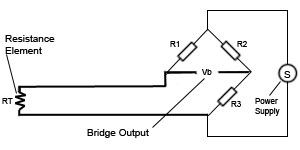
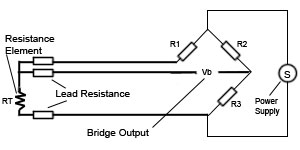
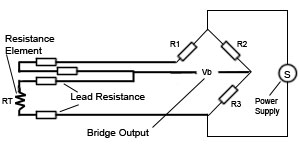
Four wire RTDs provide slightly better compensation, but are generally found only in laboratory equiptment and other areas where high accuracy is required. When used in conjunction with a 3-wire instrument, a 4 wire RTD will not provide any better accuracy. If the fourth wire is not connected, the device is only as good as the 3 wire RTD; if the fourth wire is connected, new errors will be introduced. Connecting a 3 wire RTD to a 4 wire RTD instument can cause serious errors or simply not work at all, depending on the instrument circuitry. A 2 wire RTD can be used with either a 3-4 wire instrument by jumping the appropriate terminals, although this defeats the purpose and reintroduces the uncompensated resistance of the leads. To get the optimum performance, it is generally best to specify the RTD according to the instrument manufacturer's recommendations.
Temperature Range
According to the ASTM, platinum RTDs can measure temperatures from -200°C to 650°C. You must consider the temperature limitations of all the materials involved, where they are applied, and the temperatures to which each will be exposed. A few quick examples to illustrate this point:
construction of the probe.
Accuracy
You are probably wondering why accuracy was not the first topic covered, because RTDs are generally known for their high degree of accuracy and it is typically on of the first specifications laid out. Well, the subject is not quite that simple, and it requires a bit of discussion. First, we must establish the difference between accuracy, precision, and repeatability. In the case of temperature, accuracy is commonly defined as how closely the sensor indicates the true temperature being measured, or in a more practical sense, how closely the resistance of the RTD matches the tabulated or calculated resistance of that type RTD at that given temperature.
Precision, on the other hand, is not concerned with how well the RTDs resistance matched the resistance from a look up table, but rather with how well it matched the resistance of other RTDs subjected to that temperature. Precision generally refers to a group of sensors, and if the group has good precision at several temperatures, we can also say that they are well matched. This is important when interchangeability is a concern, as well as in the measurement of temperature gradients. Repeatability can best be described as the sensor's ability to reproduce its previous readings at a given temperature.
Here's an example. An ice point reading is done with an RTD that is then used to take reading at 100°C, 150°C, 37°C and again at 0°C. A comparison of the first and last ice point readings will give you an indication of the sensor's repeatability under those conditions. A note of caution, however: an RTD's repeatability is very application-dependent. So when you get right down to it, accuracy without repeatability is worthless. If you start with a sensor that is ±0.03°C at 0°C but is found to have repeatability only around ± 0. 5°C, what you have is a sensor whose readings are far less reliable than a standard-accuracy probe with good repeatability. A high-accuracy RTD installed in a field application also does not ensure that you will be getting a highly accurate signal back at the control room.
Most 4-20 mA transmitters and many display units and controllers have adjustable zero and span controls that if improperly adjusted will destory the high accuracy of the RTD signal. The best solution for applications of this type is to have noth the RTD and the transmitter, or display, calibrated as a unit by a certified calibration laboratory.
Fortunately, the requirements for this degree of accuracy best solution for applications of this type are few and far between. For more on this subject see, Accuracy Standards. Our final two parameters are application dependent and vary from the specification of a bare resistance element to a large industrial assembly with thermowells, connection heads, and possibly field -mounted transmitters. We will discuss only the most basic areas: physical dimensions and size restrictions, and material compatibility.
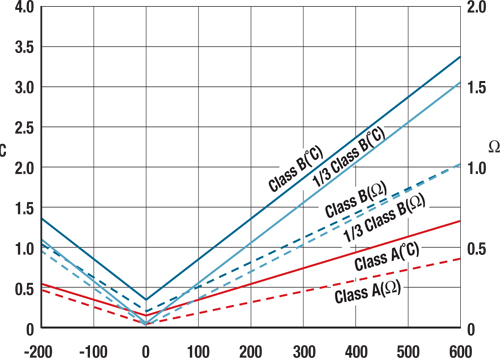
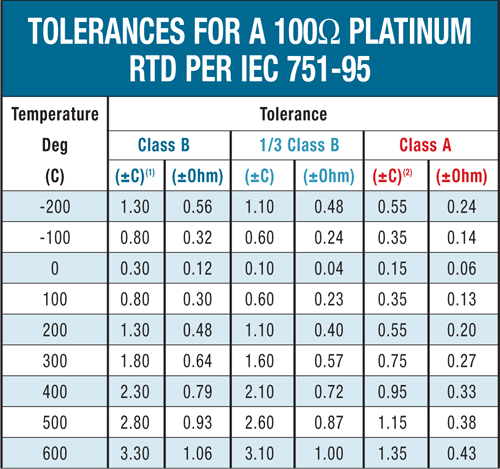
Dimensions and Size
The physical dimensions and size requirements can be more complicated than you might think. On the low end, a resistance element to be used in the construction of a sheathed RTD generally requires only that the element is small enough to fit into the desired sheath ID. For cylindrical elements, such as wire-wound units, this is obvious-just don't forget to allow for the wall thickness of the sheath. For thin film-type elements, we must apply the Pythagorean theorem; we need to know the (W) width of the element, and the (T) thickness of the element at its largest point. Then the minimum ID of the sheath will be given by; ID > (w2 + t2).
When we begin to discuss RTD probes and assemblies, the subject becomes more demanding. We need to examine the mounting arrangement: will it be used for direct immersion or with a thermowell? Or will it be something special, like an exposed airflow probe or surface mount sensor? Probe designs are endless in their configurations, and it seems that most applications have some unique requirements that make this a rather creative field in itself.
In many applications, the probe is immersed in a small vessel or piping system. Dimensions here are generally limited to sensor diameter (which affects response time); immersion depth into the fluid; and the mounting arrangement, i.e., will the sensor be screwed into a threaded port, typically with ANSI tapered threads, or will it be used in con-junction with a fluid seal already in place? Or will some other special considerations need to be made? There may be other variables, such as pressure limitations or high flow, depending on the complexity of the application. It is always best to look at the whole picture. and then discuss it with your applications engineer.
Thermowells are generally used for larger vessels and systems so that the system will not have to be drained in the event the sensor requires calibration or changing. Assuming the thermowell has already been specified, we need only to specify the probe diameter (typically ¼ in. OD for a 0.260 in. bore well), the depth of the thermowell bore, and how the RTD will be secured into the well (typically spring-loaded through a ½ in. NPT nipple or hex-nipple).
Material Compatability
Most people specifying RTD probes have to pay attention only to the chemical compatibility that will prevent corrosion. This is generally straightforward and guidelines can be taken from other materials used in the system in which the RTD will be installed. If the piping system is constructed of 316 S.S., then the probe probably should be also. But always check a corrosion guide for corrosion rates and material recommendations if you have the slightest doubt.
For applications involving thermowells, the thermowell will carry the burden of corrosion protection. However, be sure to protect the connecting wires and any terminals or plugs from possible corrosion caused by splash or corrosives in the atmosphere.
Summary
There are quite a few things to be considered when specifying an RTD probe or even resistance elements. But it's just a matter of applying a bit of common sense and using information from the application environment to set down a clear set of requirements. And if there is something you are uncertain about, get your background information together and call that applications engineer. We cant all be experts at everything.